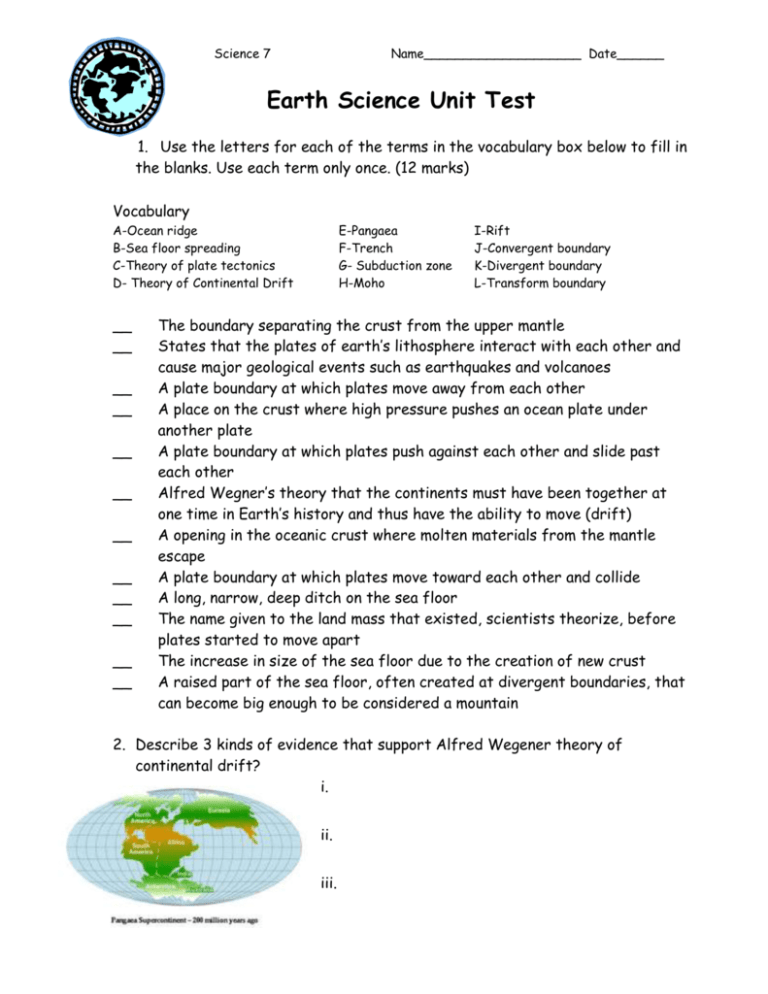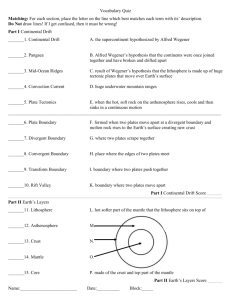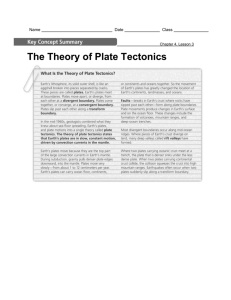UNit 2 earth science quiz
advertisement

Science 7 Name____________________ Date______ Earth Science Unit Test 1. Use the letters for each of the terms in the vocabulary box below to fill in the blanks. Use each term only once. (12 marks) Vocabulary A-Ocean ridge B-Sea floor spreading C-Theory of plate tectonics D- Theory of Continental Drift __ __ __ __ __ __ __ __ __ __ __ __ E-Pangaea F-Trench G- Subduction zone H-Moho I-Rift J-Convergent boundary K-Divergent boundary L-Transform boundary The boundary separating the crust from the upper mantle States that the plates of earth’s lithosphere interact with each other and cause major geological events such as earthquakes and volcanoes A plate boundary at which plates move away from each other A place on the crust where high pressure pushes an ocean plate under another plate A plate boundary at which plates push against each other and slide past each other Alfred Wegner’s theory that the continents must have been together at one time in Earth’s history and thus have the ability to move (drift) A opening in the oceanic crust where molten materials from the mantle escape A plate boundary at which plates move toward each other and collide A long, narrow, deep ditch on the sea floor The name given to the land mass that existed, scientists theorize, before plates started to move apart The increase in size of the sea floor due to the creation of new crust A raised part of the sea floor, often created at divergent boundaries, that can become big enough to be considered a mountain 2. Describe 3 kinds of evidence that support Alfred Wegener theory of continental drift? i. ii. iii. 3. Label the diagram below with the parts of the earth. Describe two characteristics of each layer. A B C D Layer A Name of Layer Characteristic of Layer B C D 4a. In the diagram below, label it with the following terms: oceanic crust subduction zone lithosphere continental crust asthenosphere trench Use arrows to point to each specific area on the diagram. (6 marks) 4b. Is the diagram on the previous page an example of a convergent, divergent or a transform boundary? Explain how you know. (2 marks) 5. Explain the diagram below. Also, indicate on the diagram where the youngest and oldest crust is found. (4 marks) 6. What is the name given to the theoretical supercontinent that occurred about 250 million years ago? _______________ (1 mark) 7. Why is the inner core solid, not liquid, despite the extreme heat? (1 mark) 8. Explain how it is that even though new crust is continually being made at divergent boundaries, the size of the Earth does not increase? (2 marks) 9. Use the diagram below to help you explain the theory of plate tectonics. You must use the following terms: (6 marks) mantle, lithosphere, asthenosphere, magma, convection current, heated, cools, plates, upwelling, down-welling, ridges, trenches. 10. True or False. If the statement is false, edit and correct it to make it true. __ New crust is formed at convergent boundaries. (8 marks) __Convection occurs in the lithosphere of the earth. __The lithosphere forms the Earth’s plates. __The inner core is solid and the outer core is liquid. __Transform boundaries most often cause earthquakes not volcanoes. __The inner core is primarily composed of iron (Fe) and nickel (Ni) __The asthenosphere is the semi-liquid area of the upper and lower mantle. __The Earth’s magnetic field reverses every several thousand years. 10 a. What is the Ring of Fire? (2 mark) 10 b. On the map below sketch the location of the Ring of Fire. (1 mark) How does the Ring of Fire support the Theory of Continental Drift and the concept of a supercontinent? (2 bonus marks)









